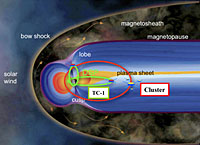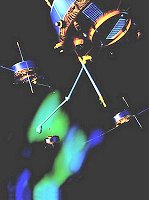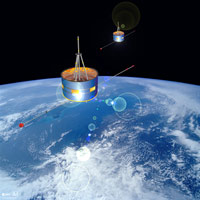 | By Dave Mosher Staff Writer posted: 15 October 2007 06:53 am ET |
Jupiter's volcanic moon Io is veiled by a thin atmosphere, but how much its volcanoes and chunks of frozen gas contribute to its atmosphere has puzzled scientists for decades.
The New Horizons spacecraft recently documented the moon's glowing aurora, however, giving researchers a chance to solve the atmospheric mystery.
Io is the most volcanically active object in the solar system. The moon's pockmarked and colorful appearance is not unlike a pepperoni pizza.
"Io is volcanically active, and that volcanism ultimately is the source material for Io's sulfur-dioxide atmosphere," said Kurt Retherford, a space scientist at the Southwest Research Institute in San Antonio. "But the relative contributions of volcanic plumes and sublimation of frosts deposited near the plumes have remained a question for almost 30 years."
Io's volcanoes spew out sulfur dioxide, which is a gas that stinks of freshly lit matches and almost entirely makes up the moon's atmosphere. As Io rotates from daylight into darkness, chilling the yellowish rock down to -226 F (-143 C), the gas freezes into a solid, much like dry ice (frozen carbon dioxide gas).
"The atmosphere at that point collapses down so that all that is left supplying the atmosphere are the volcanoes," Retherford said.
Because Io's volcanic gas stays warm enough not to freeze and creates glowing auroras, scientists were able to find out how much the volcanoes supply Io's atmosphere by measuring the moon's nightside aurora.
About 1 to 3 percent of Io's dayside atmosphere, it turns out, is created by the volcanoes. The rest is generated from frozen sulfur dioxide turning directly into gas which, over eons, has accumulated on Io's surface.
New Horizon's used its Alice ultraviolet spectrograph to capture images of Io's auroras on the spacecraft's way to Pluto, which mission scientists expect to reach in 2015. Retherford and his colleagues' findings based on the Alice data are detailed in a recent issue of the journal Science.





